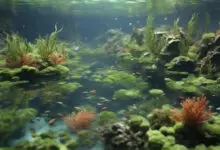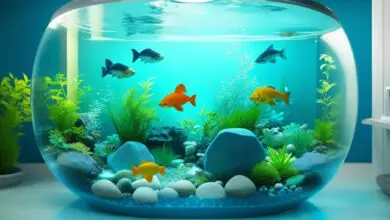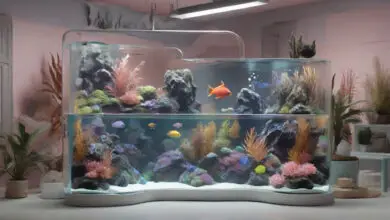Keeping Nitrates Low in Your Tank

Managing water quality is an essential part of fishkeeping. Of all the compounds to control, nitrates are one of the most important for longtime tank health. Nitrates are produced as a byproduct of the nitrogen cycle from fish waste and excess food. At low levels they are safe. But if allowed to accumulate, they can severely impact inhabitants.
Luckily, there are many methods both new and experienced aquarists can use to control nitrates. With consistent testing and the right equipment, keeping levels low is quite achievable. This guide will cover all the basics about nitrates and how to manage them in established freshwater and saltwater tanks through filtration, water changes, deep sand beds and more.
What Are Nitrates and Why Do They Matter?
Nitrates, with the chemical formula NO3, are a nitrogen-based nutrient. They form as bacteria break down toxic ammonia released from fish, waste and uneaten food. While not as immediately dangerous as ammonia or nitrites, elevated nitrates over time cause:
- Stunted growth and health issues
- Increased algae overgrowth
- Lowered oxygen levels – stress and illness
The key is keeping nitrates under 40 ppm (or 20 ppm for sensitive species). Routine testing and water changes are the first line of defense. For persistent nitrate issues, specific filters and media can lower levels for clearer, healthier water.
Ways to Remove Nitrates from Established Aquariums
The following methods help eliminate nitrates from existing tanks struggling with higher readings:
Regular Partial Water Changes
Frequently replacing a portion of water is the simplest way to dilute nitrates. For established tanks:
- Change out 25% weekly for freshwater tanks
- Aim for 10% bi-weekly on marine tanks
When refilling, use a gravel cleaner to remove debris while changing water. Remember to carefully temperature match and dechlorinate!
Filter Cleanings & Media Swaps
Don’t forget about filter maintenance when addressing nitrates:
- Rinse mechanical media monthly in old tank water to clear waste
- Replace chemical filtration every 2 months as absorption decreases
- Limit bio-media cleaning to preserve nitrifying bacteria
Adding purigen and activated carbon in a hang on back, sump or canister filter helps further polish out organics before they decay into nitrates.
Deep Sand Beds
Some tanks can utilize deep sand beds (DSBs):
| Depth | Benefits |
|---|---|
| 1”+ | Removes nitrates and wastes anaerobically |
| 4”+ | Also filters water through substrate |
These beds allow deep cleaning where oxygen is lacking. They especially help saltwater tanks but require knowing safety limits before attempting.
Algae Turf Scrubbers
For saltwater reef keepers, algae turf scrubbers can rapidly strip nitrates using fast growing macroalgae:
- Chaetomorpha works well to export nutrients
- Effective for tanks with higher lighting and flow
- Require correct balance to prevent algae escaping!
These units hang on back and shine light to grow the algae which soaks up nitrates and phosphates.
Fuges and Refugiums
Another way to export excess nutrients using algae is with refugium sumps. These use plant growth to absorb nitrates.
Benefits include:
- Added water volume dilutes waste
- Grow macroalgae without infecting display
- Provides habitat for coilpepods and amphipods
This does require drilling the tank and setting up an under-tank sump. But done properly, nitrates can be kept extremely low.
Nitrate Reducing Filter Media
Specialized filter media like Seachem DeNitrate (or Matrix in saltwater) can soak up excess nitrates:
|
|---|
These can all go in a canister or hang on back filter to scrub water clean as it passes through. They each last a different duration before needing to be replaced.
Reverse Osmosis or Deionized Water
When mixing up new saltwater or topping off tanks, use reverse osmosis (RO) or deionized (DI) water which contains zero nitrates:
- Reduces water hardness and nitrate levels
- Prevents concentration from evaporation
- Requires remineralization before use
Just watch that pH doesn’t bottom out. Blending the pure water with tap water helps avoid this.
Aquatic Plants and Floaters
For freshwater planted setups, include fast growing stem plants and floaters:
- Floaters shade light limiting algae growth
- Root feeders like amazon sword help export nitrates
- Requires sufficient lighting for growth and spread
- Often needs added fertilization depending on species
The right plant balance removes wastes without becoming overgrown. Prune and thin aggressive plants as needed.
Cleaner Crews
Certain algae eating fish and inverts are another line of defense:
- Nerite snails and shrimp graze all day
- Plecos and other algae eaters clean hardscape
- Best for mature tanks with ample hiding spaces
- May increase bioload if overstocked!
Only add what your tank can support. Factor in their waste and nutritional needs too. But the right cleaner crew certainly does their part eating algae and debris.
Nitrate Reactors
Advanced systems contain specialized nitrate reactors:
- House anaerobic denitrifying bacteria
- Convert nitrates into nitrogen gas
- Require completely oxygen-free zones
- Can be challenging maintaining proper conditions
These are complex setups requiring very careful balance. But if engineered correctly, they are extremely efficient for near zero nitrate levels.
Steps For Reducing Nitrates in Already Set Up Tanks
Bringing down high nitrates in existing aquariums takes some patience and a multi-pronged gameplan. Avoid trying to do too much too quickly. Here are the basic steps:
1. Stop Overfeeding
Overfeeding is one of the fastest ways to spike nitrates. Start by reducing feeding amounts, frequency and closely watching fish eat. Target feeding rather than flaking food everywhere. Siphon out anything uneaten after a few minutes.
2. Clean Gravel and Decor
During water changes, be sure to use a gravel vacuum to suck up any debris or mulm sitting on the substrate. Also wipe down any rocks, wood or tank walls that may have buildup contributing to high nitrates.
3. Add Chemical Media
Supplement existing filters with chemical media like activated carbon, purigen or matrix carbon to absorb organics. This provides extra assistance removing waste between gravel cleanings.
4. Upgrade Filtration
Consider adding extra hang-on-back filters or canister filters to increase biological capacity if water flow allows. Added circulation and filtration is key to reducing nitrate creep.
5. Test Often
Check nitrate readings twice a week when first addressing high levels. This helps gauge if corrective measures are working and how quickly it is improving. Testing guides next steps – water changes, media replacements, etc.
6. Find the Balance
It can take a few weeks to see results as filters catch up and algae rebalances. Persist in fighting the root causes rather than drastic measures that cause big swings. Gradual sustainable change keeps fish happy!
With some adjustments and a watchful eye, newly setup tanks can avoid nitrate issues. And even established tanks with high readings can be brought back down to safe levels. Easy enough for beginners yet essential even for experienced keepers pushing their systems.
Conclusion
Left unchecked, rising nitrates eventually impact inhabitant health, plant growth and algae control. But with routine testing and leveraging various removal methods, any tank can achieve that crystal clear water we strive for.
The key is staying vigilant using a layered defense of water changes, chemical media, algae control and proper feeding. Check other tank parameters too that might be contributing. Be patient and let the tank find its balance again.
Keeping nitrates in check takes some effort but pays back over time with vibrant fish, lush plant growth and minimal algae to keep scraping off glass and decorations! Don’t let it slide and have to deal with advanced nitrate issues. Start right away if your test kit shows higher readings – invite some snails over to help clean up







